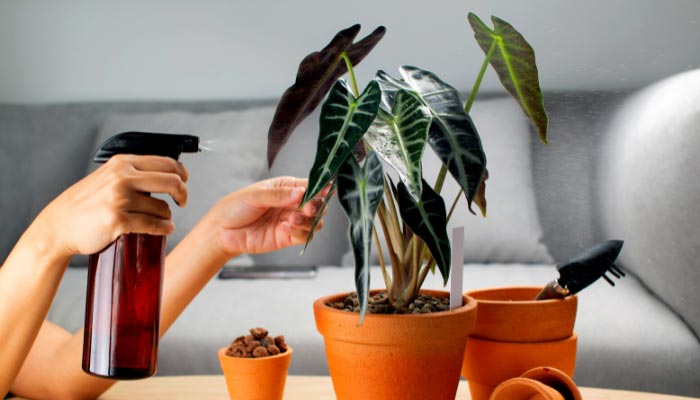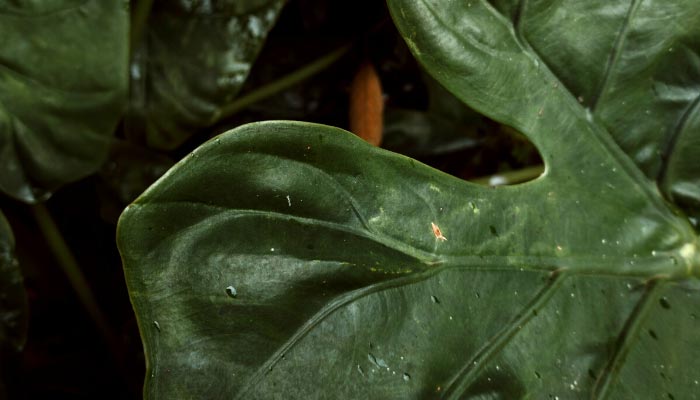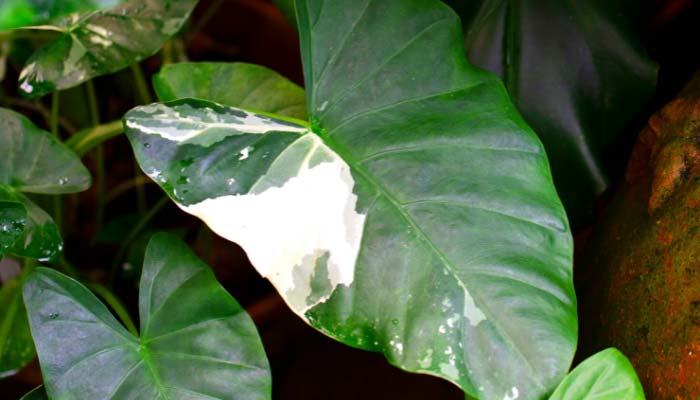Surely the little queen or the black velvet alocasia becomes the queen of the garden because of their beautiful velvety foliage. But the problem begins when you find Alocasia black velvet yellow leaves. There can be many reasons behind it like improper watering, soil problems, pest and disease attacks, fertilization issues, weather problems, and many more!
Undoubtedly, the dark, heart-shaped, thick, and succulent leaves are the main attraction but brown or yellow spots just make the leaves unattractive.
So, it is obvious that you want to fix the yellow leaves of your black alocasia as soon as you detect it. Therefore, to help you with the probable reasons and possible solutions we have come up with this writing. Bear with us till the end.
| Reasons | Fixing Guide |
| Inconsistent watering | Apply water once a day early in the morning |
| Sunlight issues | Keep in bright and indirect light |
| Disease attacks | Apply Fungicide |
| Pest attacks | Apply Pesticide |
| Humidity and temp. stress | Ensure a favorable environment |
| Nutrient deficiency | Nitrogen-based or slow-release fertilizer |
Why does My Alocasia Black Velvet has Yellow Leaves? – Solution
1. Inconsistent Watering
 Inconsistent watering is probably the main reason your black velvet alocasia leaves are yellowing. There are many sources where different ideas are shared regarding the watering of alocasia.
Inconsistent watering is probably the main reason your black velvet alocasia leaves are yellowing. There are many sources where different ideas are shared regarding the watering of alocasia.
However, you may also come across such information where it is said that alocasia loves frequent watering. Rather the truth is they love to be dry a bit but not entirely dry. Thus, overwatering causes the alocasia leaves to turn yellow.
Overwatering causes a water-logged situation in soil and eventually, it causes root rot of alocasia. As a result, the roots cannot absorb oxygen. Consequently, it turns the leaves brown. Moreover, it also affects the soil where the plant is planted.
Then again, not watering at all will also affect the black velvet leaves. It will cause drought and remaining in drought conditions for a long time will wilt the leaves turning them yellow.
Symptoms
- Lower leaves become wilted and yellow first.
- Sickly roots with curled leaves.
- The tips of the leaves start to become brown.
- The soil spreads a foul smell.
Control Measure
As soon as you discover that the alocasia plant root system is going through that phase of fungal infection, prompt treatment should be taken.
Thus, to check on the roots, you may have to pop out the plant from the pot and check out the root system. If you see mushy and fragile roots with brown or black color then you need to get rid of them.
Cut off the rotten roots with the help of a pair of scissors or pruners. Make sure the tools are sterilized.
Also, you have to exchange the soil as well since the soil also gets rotten and produces a foul smell from the rotten roots. Hence, exchange the soil with fresh soil.
Again, to protect the rest of the healthy roots, you can dip them in an anti-fungal solution. Moreover, you can also adopt some organic methods as well like sprinkling ground cinnamon on the healthy root. Or dipping the roots in the solution of hydrogen peroxide.
However, to prevent this problem, proper watering of your black velvet alocasia is required. Hence, water your alocasia only when the top two-inch soil is dry. Also, do not let your alocasia live in wet conditions for a long time.
Again, to save your alocasia from underwatering, water the plant at least once every day early in the morning.
2. Sunlight Issues
(Excessive Sunlight)
Direct sunlight can turn the leaves of black velvet alocasia leaves yellow and brown. Generally, alocasia plants prefer medium to bright sunlight but it has to be indirect. Direct exposure to bright sunlight will cause sunburn to the tissues of the plant.
Consequently, the burnt areas show brown blisters later. Again, if you take your alocasia plant suddenly in a lit area from a dark area, it will react significantly. Sudden exposure can trigger the free radical influx that has been found to be destructive.
Symptoms
- Brown blisters on the plant.
- Bleached, scorched, and brown leaves.
- Drooping and wrinkling of leaves.
- Browning or yellowing of leaf tips.
Low Light
Again, keeping the plant in an entirely dark place will also affect the growth and black velvet leaves of alocasia. So, the plant is a bit scrupulous when kept in low light.
Symptoms
- Interruption in thriving.
- Stunting growth.
- Indirect yellowing of leaves.
Control Measure
Do not plant your alocasia where it gets direct sunlight. If your plant is potted, transfer the pot to the east-facing window. It is because direct sunlight enters from the west-facing window.
Also, make sure you do not keep the plant near any heat source or HVAC vents. Again, if any plant part is already damaged or burnt, you may have to remove the portion. It is because once sunburn occurs, there is no going back.
Thus, it is important to keep the alocasia plant somewhere the place is well-lit, and also the sunlight is indirect.
3. Disease Attacks
 Several diseases are responsible for turning alocasia leaves yellow. They can be fungal, bacterial, or parasitic diseases. Even though this plant is quite resistant but there are some certain diseases that can attack them.
Several diseases are responsible for turning alocasia leaves yellow. They can be fungal, bacterial, or parasitic diseases. Even though this plant is quite resistant but there are some certain diseases that can attack them.
Rust Spots
It is a fungal infection that mostly invades the indoor black velvet alocasia. Generally, warm and humid conditions are favorable for the fungus to attack. Again, if you keep the plant in poor light for a long time then also this fungal infection may take place.
Initially, the disease creates rust spots on the leaves and gradually it invades the entire leaf. When the temperature goes higher the expansion of the disease also increases.
Symptoms
- Red rust spots on leaves
- First, affect the underside of the leaves
- Initially, the spots seem small and sometimes orangish
- Gradually, the spots largen and becomes ragged pustules
- Finally, the leaves wilt, die and drop
Control Measure
First of all, get rid of all the infected parts. Remove them and then burn them away.
Also, never let the leaves be wet while watering the alocasia. Leaving the leaves wet for too long will invite this fungal attack.
Therefore, do not go for overhead watering. Rather adopt base watering or drip irrigation to water your alocasia black velvet. Again, you can use a soaker hose.
Then again, you can adopt some homemade remedies like spraying baking soda or neem oil.
Nonetheless, if the fungal attack is in the severe stage, then you better apply copper-based fungicides specifically made for alocasia.(Our pick: Monterey LG 6145 70% Neem Oil Ready-To-Spray Insecticide, Miticide, & Fungicide)
There are some other random diseases like pythium rot, Xanthomonas, Phyllosticta leaf spot, or Anthracnose of Alocasia.
Some of them are parasitic diseases and the rest are fungal and bacterial diseases. The symptoms are given below
Pythium Rot Symptoms
- Attack the plant suddenly
- Lots of small yellow spots 2-5 cm in diameter on leaves
- The spots coalesce together and get 15 cm in diameter
- Affects the young leaves
- Leaves become wilted and drop
Xanthomonas Symptoms
- Dark-brown small spots on leaves
- Rot of leaves
- Later the spots become necrotic
- The spots merge and create irregular blotches
Phyllosticta Symptoms
- Circular or oval gray spots on leaves
- Later the spots merge and get brownish black
- Leaves scruffy holes on the leaf surface
Anthracnose Symptoms
- Affects both the leaves and roots of alocasia
- Creates pale yellow spots on the upper leaf surface
- Rust spots are seen on the leaf underside
Control Measure
Treatments for all the diseases mentioned above are almost the same. Nonetheless, first of all, you have to detect the disease according to its symptoms. Then, separate the diseased alocasia and quarantine it.
Also, trim off the affected leaves and roots and destroy them. Again, to protect the rest of the plant you can apply a Bordeaux mixture. Also, there are some antimicrobials, anti-fungal, or anti-bacterial available that you can apply to fix this problem.
However, if the infestation is in the initial stage, apply some homemade remedies. In such cases, you can apply tea tree oil or neem oil over the plant. Spraying baking soda also helps.
4. Pest Attacks
Some pests are also responsible for yellowing the leaves of alocasia black velvet. However, there are some particular insects like mealybugs, leafhoppers, aphids, and scale insects that are the main culprits. They suck the cell sap and lead the leaves to turn brown.
In some cases, the pests can attack the entire plant and damage it. With the piercing-sucking type mouthparts, the aphids can be severely destructive to the plant.
Symptoms
- Sucks cell sap and wilts the leaves
- Affects the stems and branches as well
- Makes the leaf edges brown
- Also affects the leaf veins
Control Measure
To protect from the aphids, apply a strong stream of water over the leaf surface. Also, you can handpick the pests and kill them.
Also, try applying insecticidal soap or neem oil to kill the bugs. Horticultural oil is also effective. However, keep applying the remedies every week until the black velvet alocasia completely becomes free of the pests.
However, in severe attacks, you may need to apply pesticides to get rid of the pests.
5. Humidity and Temperature Stress
Alocasia black velvet is a tropical and sub-tropical plant. Hence, the plant can thrive well in warm and humid conditions. But again, too low humidity will discolor the plant leaves making them dry. It mostly occurs during winter.
In winter, the air does not conserve moisture well, and also, the air remains crisp. Then again, too much humidity is responsible for several fungal attacks.
Also, temperature stress can cause this problem. There is a certain temperature range for the thriving of alocasia. The range is from 15 to 28 degrees Celsius. Above or below the range, can stress out the plant.
Symptoms
- Yellowing of leaves
- Edema, fungal diseases, and root rot
- Curling and dropping of leaves
- Leaf tips become brown
- Sulky leaves
Control Measure
Always try to ensure that the alocasia plant is not in adverse conditions for too long. Move the pot of alocasia from heaters or cooling vents.
Also, make sure at night you do not keep the pot on your balcony when it is winter. Again, to deal with low humidity, try misting the black velvet leaves. Moreover, ensure proper air circulation.
6. Nutrient Deficiency
 It is another crucial reason why the leaves of alocasia are yellowing. The availability of nutrients mostly depends on the soil and its fertilization. Generally, the deficiency of nitrogen, zinc, iron, and magnesium causes this problem.
It is another crucial reason why the leaves of alocasia are yellowing. The availability of nutrients mostly depends on the soil and its fertilization. Generally, the deficiency of nitrogen, zinc, iron, and magnesium causes this problem.
Symptoms
- Stunting of growth
- Yellowing of older leaves
- Chlorosis and mottling
- Curling and dropping of leaves
Control Measure
To solve this problem, you need to apply houseplant nitrogen-rich or slow-release fertilizer. Maintain the proper time for fertilizing. The right time is during early spring and fall.
Also, before planting your alocasia, make sure to have an organic fresh potting mix. Again, take the most suitable soil for planting alocasia. Coarse and free-draining soil is good for the plant. Furthermore, you can add orchid bark or perlite to the potting mix.
FAQs
Should I cut off yellowing alocasia leaves?
If the leaf has turned completely yellow then there is no chance it will become green again. So, removing it would be wise.
Should I mist alocasia black velvet?
Yes, you should but only when the humidity is too low in the environment.
Do alocasia like to be wet or dry?
They require their soil to be moist but obviously not wet. Again, they also do not want their leaves to be wet.
Final Words
Now that you know why there are alocasia black velvet yellow leaves, you can go for the proper treatment.
However, a bit of care and prevention will never let you fall into such a situation. So, if our article was helpful enough then throw your feedback as well.
Happy Gardening.
- Propagating Plumeria Trees from Cuttings: Easy Steps - July 13, 2024
- How to Plant Plumeria Clippings? Easy Growth Guide - July 12, 2024
- How to Make a Plumeria Bloom? Secret Tips Revealed! - July 12, 2024

